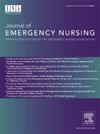Revision and Application of the Simplified Chinese Version of the Critical Care Family Needs Inventory in the Emergency Department
IF 1.8
4区 医学
Q2 EMERGENCY MEDICINE
引用次数: 0
Abstract
Introduction
The family members of patients are an important part of a patient’s social support system. The needs of the family members of patients are critical factors that medical staff need to consider when formulating treatment plans. This study aimed to culturally adjust the traditional Chinese version of the Critical Care Family Needs Inventory in the Emergency Department to the simplified Chinese version for use with families in the emergency department of mainland China, test its reliability and validity, understand the needs and factors influencing scores, and to provide a reference for promoting patient and family-centered care.
Methods
A cross-sectional survey was conducted to collect data from family members of a tertiary hospital in northeast China. This study consisted of 2 phases. Phase Ⅰ: 258 questionnaires were collected in the scale revision phase for the assessment of construct validity using exploratory factor analysis. In addition, internal consistency reliability and content validity were used to evaluate the psychometric characteristics. Phase Ⅱ: 297 family members were recruited in the cross-sectional survey phase. The data were collected through the simplified Chinese version of Critical Care Family Needs Inventory in the Emergency Department and analyzed with SPSS 26.0 Statistics software.
Results
In the scale revision phase of the study, the content validity index was 0.92, and the total Cronbach’s alpha coefficient was 0.87. In the cross-sectional survey phase, the mean score of family members’ needs was 109.2 ± 9.8 (95%CI 108.1, 110.4). Age (P = .019), residential address (P = .001), income (P = .004), and triage category (P = .001) are independent factors influencing total scores.
Discussion
Our findings suggested that the Simplified Chinese version of Critical Care Family Needs Inventory in the Emergency Department is a valid and reliable scale for use within mainland China. The needs of family members are at a high level. Hence, emergency nurses need to acquire more knowledge about family needs to better consider and address their needs.
重症监护家庭需求清单简体中文版的修订和在急诊科的应用。
引言病人家属是病人社会支持系统的重要组成部分。患者家属的需求是医务人员在制定治疗方案时需要考虑的关键因素。本研究旨在将繁体中文版《急诊科危重病人家属需求量表》调整为简体中文版,供中国大陆地区急诊科家属使用,检验其信度和效度,了解家属的需求和影响评分的因素,为促进以患者和家属为中心的护理提供参考:方法:我们在中国东北某三级甲等医院开展了一项横断面调查,收集患者家属的数据。本研究分为两个阶段。第Ⅰ阶段:在量表修订阶段收集了 258 份问卷,采用探索性因素分析法评估量表的建构效度。此外,还采用了内部一致性信度和内容效度来评估心理测量学特征。第Ⅱ阶段:横断面调查阶段招募了 297 名家庭成员。在急诊科通过简体中文版重症监护家庭需求量表收集数据,并使用 SPSS 26.0 统计软件进行分析:在量表修订阶段,内容效度指数为 0.92,总 Cronbach's α 系数为 0.87。在横断面调查阶段,家庭成员需求的平均得分为 109.2 ± 9.8(95%CI 108.1,110.4)。年龄(P = .019)、居住地址(P = .001)、收入(P = .004)和分流类别(P = .001)是影响总分的独立因素:讨论:我们的研究结果表明,简体中文版的《急诊科危重症患者家属需求量表》在中国大陆使用是有效且可靠的。家庭成员的需求处于较高水平。因此,急诊护士需要掌握更多有关家庭需求的知识,以便更好地考虑和满足他们的需求。
本文章由计算机程序翻译,如有差异,请以英文原文为准。
求助全文
约1分钟内获得全文
求助全文
来源期刊
CiteScore
3.10
自引率
11.80%
发文量
132
审稿时长
46 days
期刊介绍:
The Journal of Emergency Nursing, the official journal of the Emergency Nurses Association (ENA), is committed to the dissemination of high quality, peer-reviewed manuscripts relevant to all areas of emergency nursing practice across the lifespan. Journal content includes clinical topics, integrative or systematic literature reviews, research, and practice improvement initiatives that provide emergency nurses globally with implications for translation of new knowledge into practice.
The Journal also includes focused sections such as case studies, pharmacology/toxicology, injury prevention, trauma, triage, quality and safety, pediatrics and geriatrics.
The Journal aims to mirror the goal of ENA to promote: community, governance and leadership, knowledge, quality and safety, and advocacy.

 求助内容:
求助内容: 应助结果提醒方式:
应助结果提醒方式:


